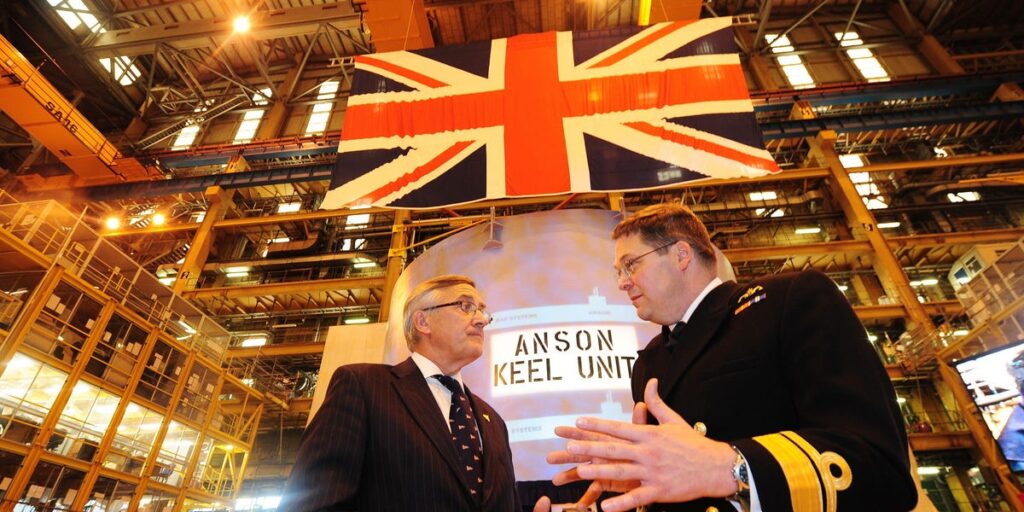When Calvin Bailey — a member of the UK parliament — was a squadron commander in the country’s Royal Air Force, he saw a shift in how his engineering-heavy workforce changed careers.
In the early 2010s, people would leave the service “like for like,” he told Business Insider — meaning they were leaving the military for complementary roles in the defense and aerospace industry.
However, by around 2017, he said, a new sprawl of high-tech companies and major infrastructure projects created a demand for skills that the military had nurtured, such as robotics, advanced engineering, and logistics.
Bailey wrote in a recent piece for War on the Rocks that he watched as the military “hemorrhaged” certified aircraft engineers.
“I found myself competing with unlikely adversaries: Amazon logistics hubs,” he wrote.
As the UK attempts to redress the effects of decades of reduced military spending, it’s not just a steep price tag that has experts worried. It’s a shrunken — and highly competitive — skills pipeline.
Bailey still doesn’t think the UK is spending enough, he told BI. But even if the country throws money at it, “you haven’t got the skills base with which to go and do the work that’s required.”
A skills shortage in the defense industry
Paul Oxley, a spokesperson for UK defense trade association ADS Group, told BI that demand for skilled workers now presents the defense industry’s “largest barrier for growth.”
This covers everything from traditional skills like welding and high-end engineering, to growing fields like cybersecurity, digital, and AI capabilities.
Oxley said that surveys of ADS members have seen the issue of talent leapfrog energy prices to become the top worry for many companies.
These concerns come amid an increased commitment by the UK to defense spending — to 2.5% of GDP — that has defense-related industries looking out for new orders.
Big projects are already in the works. Dreadnought-class submarines, the Tempest fighter jet, and Type 26 and 31 frigates are due to come into service in the next decade or so.
Yet in March, Kevin Craven, the head of ADS Group, warned lawmakers that skills shortages are “combining to a point where both the defence and aerospace industry cannot fulfil the demand that they have.”
These warnings also come as the government prepares to publish its latest Defence Industrial Strategy, which a Ministry of Defence spokesperson said will help the UK have the “capability, skills and industrial resilience” for warfighting.
Multiple skills initiatives are already underway, they added.
An ‘arms race’ for skills
The UK’s defense sector pays an average of £39,900, Oxley said, which is about $53,000 and around 14% higher than the national average.
But even that can’t always compete with other sectors, Bailey, the MP, said.
Meanwhile, many companies, like Amazon, actively recruit UK veterans as part of a government program pledging to support post-service careers. Amazon declined to comment when approached by BI.
Bailey shared that other competing industries include infrastructure projects, such as the recent nationwide rollout of electric smart meters.
He told BI those leaving the RAF for such companies “would find an easier job — because it’s less regulated and controlled and demanding on their skills — paying equal or more than they would expect on the general market.”
In addition, security clearances make it hard to hire from abroad — and in any case, the UK’s nearest European defense industry neighbors are themselves in a scramble for talent.
A shortage decades in the making
The expansion of a talent-hungry tech sector compounds a much longer-running skills issue.
Andrew Kinniburgh, a spokesperson for manufacturing industry trade body Make UK, told the Defence Select Committee in March that the country is in an “arms race” for engineers.
Campaigners say STEM has been neglected from the earliest schooldays up, causing a shortage that has seen all sectors — not just military — competing for talent.
That situation wasn’t helped by the Apprenticeship Levy, a 2016 attempt to invigorate private sector investment in training. It was so cumbersome that schemes fell by 172,000 across all sectors in its first year, according to HR industry body CIPD.
The government now says it’s streamlining the process.
The looming threat of ‘skill fade’
Industry experts told BI that another reason defense sector workforce skills have atrophied is a long-term lack of investment in the military that began in the 1990s.
The defense ministry spokesperson told BI that the current government is addressing the country’s security “after years of hollowing out.”
People like naval architects and high-level engineers take decades to nurture, and when orders dry up, “you have skill fade in these areas quite quickly,” said Sam Cranny-Evans, a freelance defense analyst and associate fellow at the Royal United Services Institute.
“Once they’re gone, they’re gone,” he told BI. “Standing them up again is really hard.”
COVID-19 lockdowns haven’t helped. Suddenly, people with 10 to 15 years left in their careers decided to accelerate their retirement plans, leaving what Oxley called a “handover cliff edge” and a decadelong knowledge gap.
The problem has come to a head before.
In the early 2000s, BAE Systems took over a contract to produce the Astute-class submarine, following a 10-year gap since the development of the earlier Vanguard-class sub.
Dated skills — among other factors — became a major problem, forcing the UK to bring in General Dynamics Electric Boat, a US company, to help at an eventual cost of about $145 million.
The project ran years late, exceeded its budget by hundreds of millions of pounds, and spurred multiple reckonings that still reverberate today.
Janet Garner, BAE Systems’ future workforce director for submarines, told BI the company is focused on ensuring it has a strong submarine workforce. She highlighted its $33.5-million training center and said early careers programs are “up to record levels.”
An analysis by Navy Lookout highlighted lessons learned, saying that the next-generation Dreadnought went into production with a much more experienced workforce. But across the industry, there’s a long road ahead.
A ‘puddle’ of talent
Oxley and Bailey say there’s a lot more to be done, and that skills need to be addressed at the level of education. Both are calling for schools and colleges to develop applied STEM curricula showcasing the appeal of working in defense.
Encouraging a much more flexible career structure, allowing people to “zig-zag” between the military and civilian sectors and making the relationship complementary rather than competitive, is also among the suggestions being made.
Tan Dhesi, a lawmaker heading up the UK parliament’s Defence Select Committee, declined to comment in detail while the inquiries continue, but said that he had seen “clear and consistent” evidence that the issue needs addressing.
“We need a sea of talent,” Oxley said. “At the moment, it’s a puddle.”
Read the full article here
















